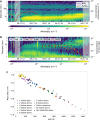Frequent new particle formation over the high Arctic pack ice by enhanced iodine emissions
- PMID: 33004812
- PMCID: PMC7529815
- DOI: 10.1038/s41467-020-18551-0
Frequent new particle formation over the high Arctic pack ice by enhanced iodine emissions
Erratum in
-
Publisher Correction: Frequent new particle formation over the high Arctic pack ice by enhanced iodine emissions.Nat Commun. 2020 Oct 28;11(1):5557. doi: 10.1038/s41467-020-19533-y. Nat Commun. 2020. PMID: 33116133 Free PMC article.
Abstract
In the central Arctic Ocean the formation of clouds and their properties are sensitive to the availability of cloud condensation nuclei (CCN). The vapors responsible for new particle formation (NPF), potentially leading to CCN, have remained unidentified since the first aerosol measurements in 1991. Here, we report that all the observed NPF events from the Arctic Ocean 2018 expedition are driven by iodic acid with little contribution from sulfuric acid. Iodic acid largely explains the growth of ultrafine particles (UFP) in most events. The iodic acid concentration increases significantly from summer towards autumn, possibly linked to the ocean freeze-up and a seasonal rise in ozone. This leads to a one order of magnitude higher UFP concentration in autumn. Measurements of cloud residuals suggest that particles smaller than 30 nm in diameter can activate as CCN. Therefore, iodine NPF has the potential to influence cloud properties over the Arctic Ocean.
Conflict of interest statement
The authors declare no competing interests.
Figures




References
-
- Masson-Delmotte, et al. Global Warming of 1.5°C. An IPCC Special Report. Report of the Intergovernmental Panel on Climate Change (2018).
-
- Kay JE, et al. Recent advances in Arctic cloud and climate research. Curr. Clim. Chang. Rep. 2016;2:159–169. doi: 10.1007/s40641-016-0051-9. - DOI
-
- Stevens RG, et al. A model intercomparison of CCN-limited tenuous clouds in the high Arctic. Atmos. Chem. Phys. 2018;18:11041–11071. doi: 10.5194/acp-18-11041-2018. - DOI
-
- Kapsch ML, Graversen RG, Tjernström M, Bintanja R. The effect of downwelling longwave and shortwave radiation on Arctic summer sea ice. J. Clim. 2016;29:1143–1159. doi: 10.1175/JCLI-D-15-0238.1. - DOI
Publication types
LinkOut - more resources
Full Text Sources

